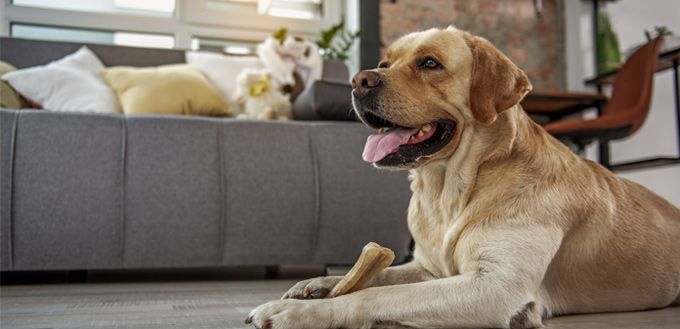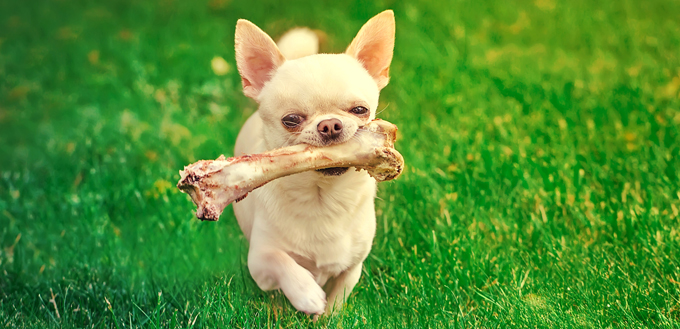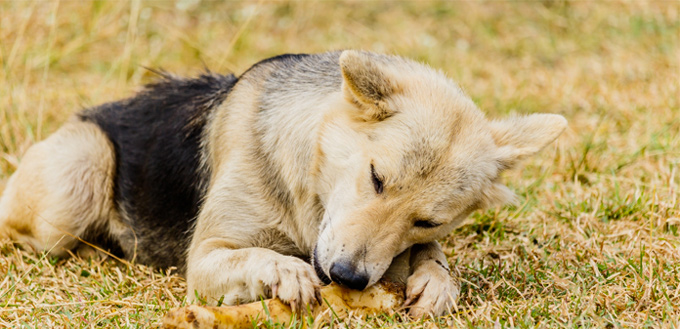We are always told that giving bones to our dogs can lead to a host of problems like cracked teeth, blockage in their intestines, and even choking in some cases. But if you look at canine ancestral diets, long before dogs were domesticated by man and turned into pets, these dogs subsisted on almost anything and everything they could find in Mother Nature’s backyard, bones, and all. True, ancient man didn’t have the scientific tools to determine whether ancient dogs have the same problems vets and many pet parents today have about feeding dogs bones. But the point is that dogs are omnivores and are also considered predators in the wild. They’re specially built by Mother Nature to digest and process raw meats, bones, and internal organs. So why stop now?
In this article we shall try to explore why giving bones to your dog can actually be beneficial. Perhaps more importantly, we will look at how you can give your dog bones the correct way as well as how to address some of the issues raised by some folks about the practice of feeding dogs bones.

Related Post: Best Bones for Dogs
Why Giving Fresh Raw Bones to Your Dog is Beneficial
There are many reasons why giving your dog bones is considered to be highly beneficial. Here are a few of the more important reasons:
- More powerful stomach acids for easier digestion
Studies show that dogs fed with raw food – meats, bones, and all – have an average pH of their gastric acids at 1.5. Dogs that are fed dry dog foods have stomach acids that have a slightly higher pH value, meaning a bit less acidic, at pH 2.5. While most pet parents will look at the two values as still indicative of acidity, it should be noted that pH 1.5 is more acidic than pH 2.5.
That being said, we can safely assume that dogs given raw meats and bones have a much healthier digestive system since their gastric acids are naturally more acidic. The more acidic the gastric secretions the more efficient it is when it comes to digesting any type of food molecule. Just imagine a really acidic fluid that can melt even the hardest metal. That is an exceptional analogy to how efficient the stomachs of raw-fed dogs are. What this simply means is that they are able to digest and process any type of food a lot easier and with greater efficiency.
On the other hand, dry-fed dogs have less acidic stomach acids. It is still acidic, although it may not be as efficient as that of raw-fed hounds. So if you give these dogs cooked bones, they might not be able to digest the food well for the simple fact that their gastric acids are not that acidic. This can also lead to splintering of the bone, resulting in injuries to the gut lining.
This is the reason why many vets discourage giving bones to dogs. What most fail to understand is that dry-fed dogs have less acidic stomach fluids compared to dogs that have been fed raw.
- Cleaner teeth and healthier gums
Only one in 10 dogs is fed raw. The other 9 are fed with commercially-available dry dog food. The incidence of periodontal and oral health problems in dogs is also 90 percent. Whether or not this is a coincidence doesn’t really matter. What matters is that dogs that are given raw and fresh bones end up having lower incidence of periodontal diseases like gum inflammation and tartar and plaque buildup.
While it is true that dog kibbles help prevent the buildup of plaque and tartar in dogs’ teeth and gums, they are less efficient compared to real bones and cartilage that dogs can bite, crush, and shear. These are more mechanically effective in the removal of food particles and other debris that may become the food source of bacteria and other germs that produce biofilm on the surface of the teeth.
Now it is important that only raw bones be given because these are still spongier or ‘softer’ than cooked bones. When bones are cooked, many of its mineral contents including fats and collagen are removed, leaving behind brittle bones. When your dog eats this bone, there is a chance that it will crush this and produce splinters. That is why it is best to give raw bones.
Several scientists have made a remarkable discovery that adding fresh, raw bones to your dog’s diet can actually reduce the incidence of canine dental diseases. For instance, including oxtail in the diet of dogs can eliminate dental calculus in as little as 24 hours.
- Provides essential nutrients
As we have already mentioned above, cooking bones essentially removes all the nutrients that are supposed to provide a whole lot of benefits to dogs. Meaty bones provide dogs with high-quality proteins complete with their vast array of easily-digestible amino acids for optimum growth. This easily translates to stronger and more toned muscles. And because dogs are highly active pets, having strong muscles can guarantee a healthier and more active lifestyle for your hound.
You May Also Like: High Protein Dog Food
Raw meaty bones are also filled with healthy fats and none of the trans-fats that we often associate with heavily-processed foods, even those bones that are now finding their way in pet shops. The fatty acids found in these raw bones can help ensure your dog has healthier coat and skin. It is also important in the synthesis of certain hormones while ensuring the functional integrity of all cells in the dog’s body, especially the nervous system.
Serving your pet raw meaty bones also supplies your pet with the much needed cartilage which will help improve the health of its joints. There really is no need for supplementing your hound with expensive glucosamine, MSM, and chondroitin preparations simply because it is already getting enough from the raw bones that you give it.
Raw bones are rich in calcium and phosphorus, too, further strengthening your dog’s own bones. It has selenium, magnesium, and copper for added health benefits especially in enhancing your pet’s immune system functioning.

How to Give Your Dog Bones the Correct Way
One of the biggest mistakes that people have, whenever they have to give their dogs bones, is that they cook them or, worse, they buy from pet shops bones that have been processed and packed dry that many of the bone’s essential nutrients are already gone. This is no way to provide food to our dogs. The only way – the correct way – to feed dogs bones is by giving them fresh, raw meaty ones.
The question now is where can you get high-quality meaty bones to give to your dog?
Obviously, you cannot buy raw bones from a seller with a questionable reputation. If you can source your raw bones from your trusted butcher, one whom you know stores his meat properly, then that would really be ideal. Even more ideal is if you grow the animals whose bones will eventually land on your dog’s plate. This is undoubtedly the best way you can serve your pet really high-quality raw bones.
It should be clear that raw bones should not be the only source of nutrients for your pet. Remember that your dog will also benefit from wholesome vegetables and fruits as well as healthier grains because of the nutrients and antioxidants that these foods contain. So how much raw bone should you include in your pet’s diet?
There are no standards as to the exact percentage of raw bones to give to your pet. One good measure, however, is the characteristics of your pet’s stool. If your dog is finding it more difficult to pass stools every time you give it raw bones, then that simply means that your pet is consuming more raw bones than what it is fully capable of. The same is true if you notice the color of the stool to be a bit on the yellowish-white because of the presence of calcium. Other conditions can lead to constipation and the formation of yellowish-white stools, of course. That’s why it is important to consider the timing of these observations. If you observe these after giving your dog bones, then there is a great chance you’ve given it larger amounts of bones than absolutely necessary.
Today, experts say that between 5 and 10 percent of your dog’s diet should be sufficient. What we recommend, however, is to feed your dog bones not on a daily basis but rather at least once a week. This way you can observe the 5 to 10 percent rule.
You May Also Like: Dog Bones
Issues Related to Feeding Dog Bones and How to Manage Them
It would be grossly unfair if we don’t address some of the issues raised by many pet parents regarding the feeding of bones to dogs. In this section we shall try to look at these issues one by one and determine how you can best manage these without sacrificing your pet’s need for high-quality, nutritious, and truly-beneficial raw, fresh bones.
- Cracked teeth
It is true that both cooked and fresh, raw bones can crack the teeth. However, this can be avoided by giving your dog the right kinds of meaty bones and avoiding, as much as possible, the larger leg bones. These are denser than other types of bones. And while the premolars of dogs are specially adapted for crushing any type of bone, it is crucial to avoid larger and denser bones as these can crack your dog’s teeth. A better alternative is to give your pet oxtails as these are somewhat ‘softer’ or less dense than leg bones. The bones of oxtail are also smaller, typically surrounded by meat and layers of collagenous tissues. These have greater amounts of cartilage, making it exceptionally chewy for your pet.
- Gut impaction
We mentioned that feeding dogs raw bones can help make their stomach acids more acidic. However, you need to understand that it doesn’t increase the amount of stomach acids. So if you give your pet more food than what its stomach acids can safely and efficiently process, you are essentially courting impaction in its gut. Leave a bucketful of chicken wings and your dog will be devouring it in a flash. Sadly, because of the volume of food is simply way too much for the gastric acids to process there will be instances when these undigested food materials will cause an obstruction in your pet’s gut. The issue is made worse in situations where the bone meal has been cooked. This will make it a lot easier for your dog to consume greater amounts than what its stomach can fully process.
- Choking
Any type of food has the potential to cause choking in dogs, not only bones. As such, when giving bones to dogs, it is important to be extra-vigilant. For instance, puppies and dogs that are fed exclusive kibbles or canned food all their life may be at an increased risk for choking because of softer esophagus. Dogs that are flat-faced and those with missing teeth will also find it more difficult to break down bones so that they will be a lot easier to swallow, minimizing choking. Overzealous dogs can swallow whole bones for fear that other dogs will steal it from them. As a rule, always check the size of your dog. If you’re still fearful, then give your dog bones that are ‘softer’ so that they can easily chomp down on it.
- Aggressive behavior
There are some folks who believe that giving dogs raw bones can lead to canine aggression. Unfortunately, nothing can be farther from the truth. Dogs that are feeding have a natural tendency to ‘guard’ their food. Give them a bowl of dog food and they will snarl at other dogs that go anywhere near them. The same is true with your dog’s favorite toy. Attempt to take it away and your dog will be displaying a guarding behavior. This has nothing to do with eating raw bones.

Raw, fresh, and meaty bones should be made as a regular part of your dog’s diet. It’s rich in nutrients, helps ensure healthier gums and teeth, and promotes healthier digestion, too. However, it is important that you know how to properly give your dog bones to obtain all these benefits.
Sources:
- Dog Nutrition Tips, American Society for the Prevention of Cruelty to Animals
- Can Dogs Eat Bones?, The American Kennel Club







I just got a Saint Bernard puppy. She is 12 weeks old. Can I give her a bone? Thank you.